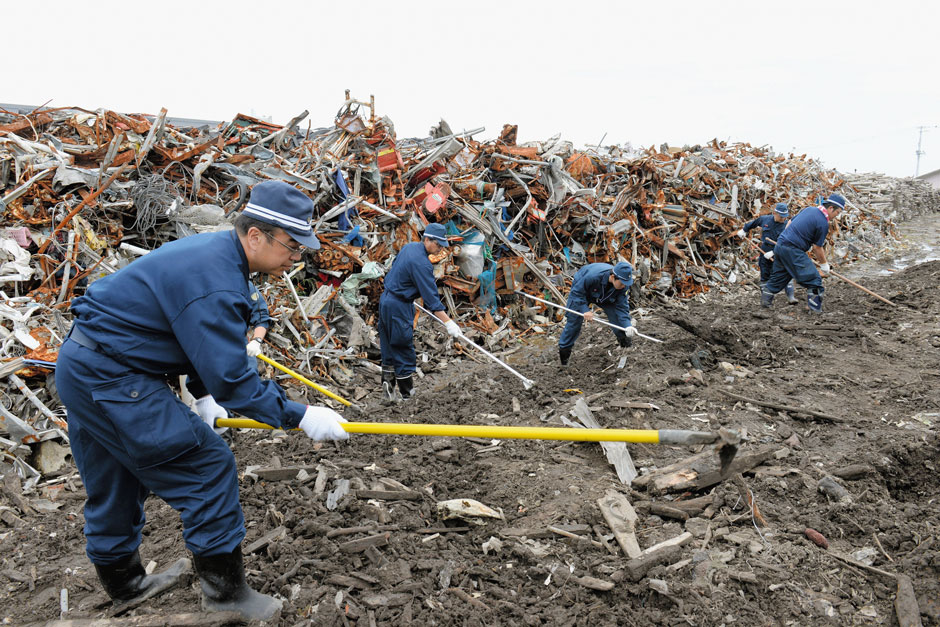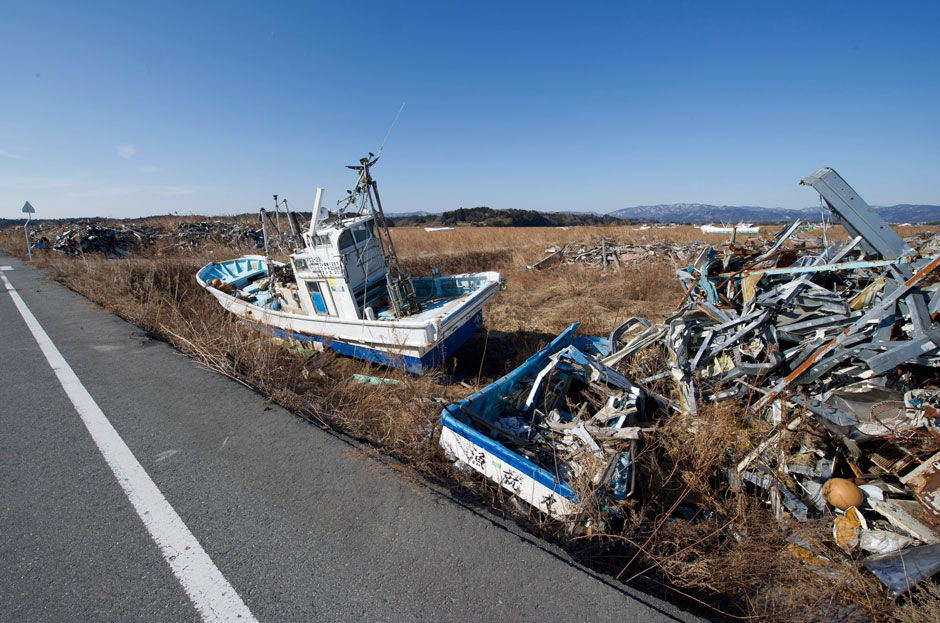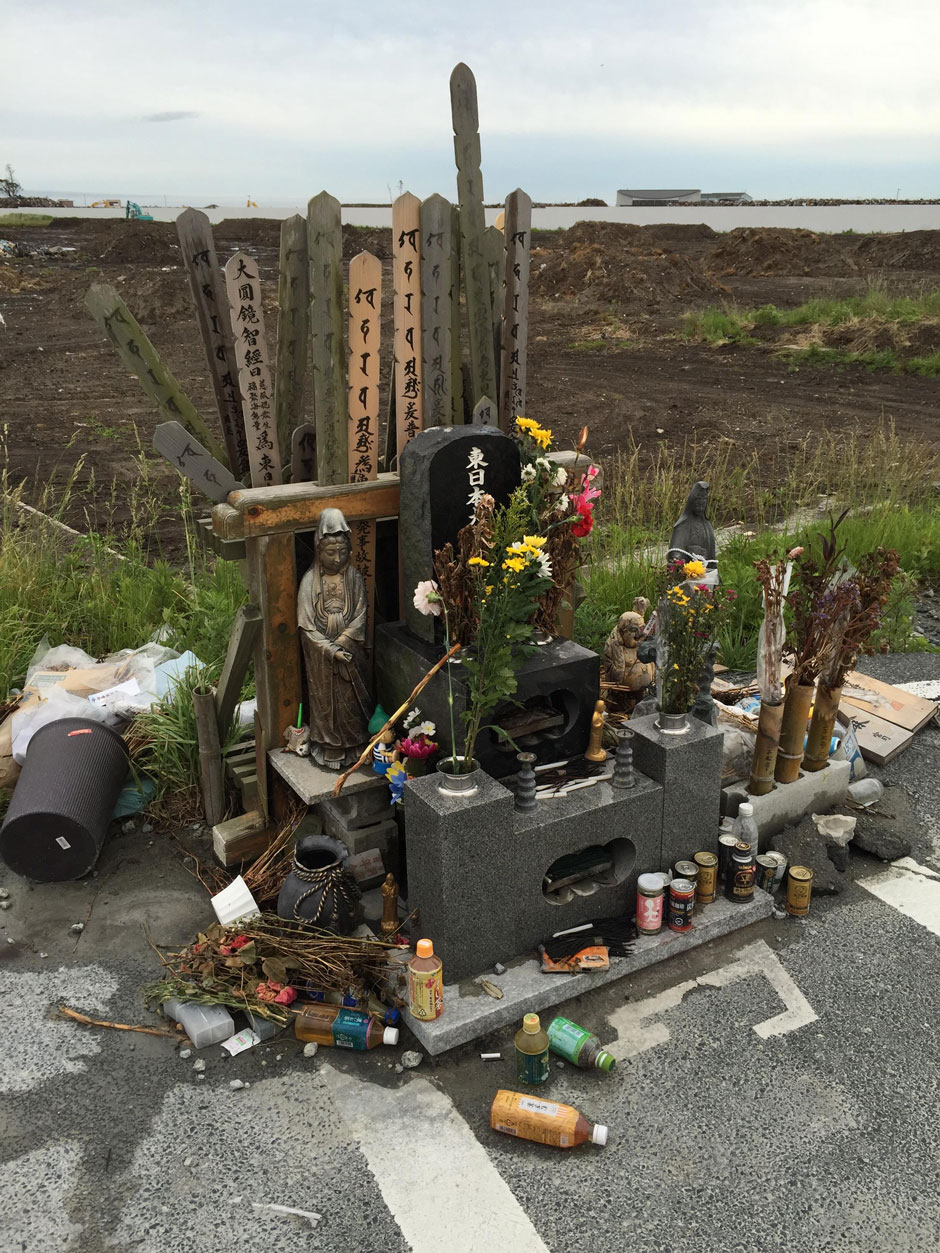Four years ago, the fishing town of Namie, on the northeast coast of Japan, lived through an experience of malediction biblical in scope. Beginning at 2:46 PM on March 11, 2011, without warning, the town’s population of 23,000 was struck by a triple disaster in quick succession: an earthquake measuring nine on the Richter scale that severely damaged the upper town, a fifteen-meter tsunami that carried away the entire lower town, and finally, in the days that followed, a blanket of radioactivity, from explosions in the Fukushima Daiichi Nuclear Power Plant just six miles away, that settled over the town’s ruins.
Today grass grows on the sidewalks in Namie. There are no cars, no people, anywhere. Through shop windows you can still see goods that tumbled off the shelves and remain on the linoleum floors gathering dust. Everything is as it was left in the panicked evacuation. In one building, the earthquake has left behind a three-inch fissure in a wall, a vase lies in pieces on the floor of a sitting room, and the windows of a sunroom have collapsed in shards. Nearby a store sign—in English—“Suzuki watch, jewelry, optical”—lies collapsed on the sidewalk; the bus shelter where the municipal buses turned around is empty; a sign saying “Louer: Total Beauty Salon” still hangs over a shuttered shop; and at the town’s main intersection, the single traffic light is still blinking on and off.
Four years after the calamity, no one from Namie can return home. It remains in the “red zone,” a contaminated area fifty miles by ten where the winds and rains carried a plume of radioactivity in the days after the disaster. Today there are parts of town where radiation measures twenty-six times the Tokyo level. Caesium-137 is washed down by the rains and accumulates in the weeds that grow near the gutters. Yet Japan—along with much of the world—still considers nuclear power an essential part of the energy mix necessary to meet the challenge of climate change.
With a team from the Carnegie Council for Ethics in International Affairs, I had signed up with a local group, Bridge for Fukushima, for a two-day tour of the zones left irradiated by the nuclear accident. Bridge is one of many groups that have sprung up since the triple disaster to breathe life back into the battered area and to dispel the fears and prejudices that the disaster has left behind. Today, Tokyo shoppers still won’t buy rice, soya, or miso produced in the region and nobody will touch the catch from the local fishermen, even though the fish have been pronounced safe.
Our group boarded a tour bus and set off into the irradiated zone in a heavy soaking rain. By the roadside, decontamination crews were at work in masks, boots, helmets, and gloves, bent over scraping topsoil into large black plastic bags. As we traveled, we gauged our own exposure to radiation with Safecast monitors. In the enclosed valleys, as our bus climbed up the winding roads towards the coast—still many miles from the nuclear plant—radiation rose to double the levels in Tokyo.
We’re told it’s safe to travel to Namie but it’s still not clear what safe means. The Chernobyl standard for safe return of people from a radiated zone was one millisievert per hour, while in Japan the government has set the standard at twenty. Anti-nuclear and environmental lobbyists insist that the Japanese standard isn’t safe.
In the Fukushima Daiichi plant, at the height of the disaster, when hydrogen explosions lifted the roofs off three of the six reactors, plant workers were exposed to radiation in the 170 to 180 millisievert range. Despite the radiation plume that forced the evacuation of 100,000 people, no one has died of radiation exposure. Doctors are monitoring 300,000 people, looking for thyroid cancer and have found eighty-eight cases so far, but no conclusive evidence that radiation was the cause. Today, at the plant itself, only robots and remote-control devices can be used in decommissioning work.
The risks of traveling into an irradiated zone may be negligible, but it takes time for your preconceptions to adjust. You expect the foliage to be bare, the rice paddies dry, the trees skeletal. In fact, nature looks normal. We made a wide circle around the most heavily contaminated zones, and then headed south down coastal highway 6. After being stopped at a checkpoint by a police officer in a white helmet and mask, we were waved into the eerily deserted red zone at Namie.
It is the invisible hazard of radiation that keeps Namie empty, but it was the visible force of the earthquake and tsunami that destroyed much of the town. When we tour the lower town, the sea becomes audible, white breakers pounding into the sand dunes on the horizon. The construction crews are building new tsunami defenses everywhere, but for townspeople, fishermen especially, who had lived with the sea and believed they knew its moods, the violence it inflicted that day still evokes awe and dread. In the photographs taken by the police days after the tsunami, there is nothing but wreckage as far as the eye can see: houses pulverized and here and there a fishing boat hurled out of the ocean. In the pictures, police wearing turquoise gloves, white decontamination suits, and goggles are poking the ruins with long poles in search of bodies. One hundred and eighty-two people drowned immediately when the tsunami struck, a little after 3:30 PM that March afternoon. A further thirty-two bodies were washed away and never recovered.
Advertisement
Now the plain, where they all once lived, is bare and desolate, the wreckage carted away. There is not much to indicate that there was a thriving town only a few years ago, beyond the straight lines where streets used to be. One of the officials who accompanied us, Masami Nakagawa, left her private-sector job in Tokyo to work here after the tsunami. Why? “Nothing else seemed so worthwhile,” she said, and we looked across a bleak landscape, under grey clouds, at the far end of which, five miles away, you could see the six bare concrete stacks of the Fukushima plant itself.
She says that the “invisible heroes” were the municipal officials who evacuated their citizens in the panic that followed and who, in the years since, have stuck with them. They have had to contend with securing compensation for victims and their families, finding housing and re-housing for them—and trying to address the endless question, which never gets a straight answer, as to when, if ever, they will be allowed to return.
Natsuko Yoshida, one of these municipal workers, told me that she hasn’t been back to her own home in four years, though she passes it nearly every day. She wonders what the food left in the refrigerator must be like now. She points out the village school, built right by the ocean, and then traces the route across the fields and up to the higher ground where the pupils, led by their teachers, fled to escape the tidal wave.
Other children met a different fate. I’ve seen a photograph taken in the schoolyard at Okawa Elementary in Ishinomaki, north of here in Miyagi prefecture, that shows the school satchels, yellow, blue, red, smeared with salt and sand, the only trace of seventy-four children who followed orders, stayed in the schoolyard, and were swept away by the tsunami. The only children to survive were those who disobeyed and ran for their lives.
Some Japanese, considering the fate of these children, fault a national tendency to stick to “rules-based” rather than “principles-based” decisions. Principles-based decisions—forget the rules, act on your best intuition and run for your lives—might have saved the children. As I listened to discussions about what they should have done, I remembered Isaiah Berlin once saying that people in safety should beware of judging the decisions that people make in danger. The children and their teachers, after all, were living the unimaginable. Who knows, really, what one would do in such a situation?
Even now, the evacuees of Fukushima are living through the unimaginable, trying to make sense of what it was like to lose everything to a fifteen-meter wall of water, as high as the light-poles, and then to have your home enveloped by a plume of radioactive caesium. Between the earthquake and the tsunami, which struck about thirty-five minutes later, Naoki Kobayashi, a city worker, then twenty-seven years old, was racing through the streets with a loudspeaker, telling people to escape. He was driving back to higher ground when he saw, in his rearview mirror, the wave roaring up behind him, chasing him like a pack of dogs.
He made it to safety, but his family’s house was washed away, and he didn’t know where his mother was until she turned up at the municipal office later that night and he loaded her onto an evacuation bus. Four years later, both he and his mother are still living as evacuees.
The memories of that time after the disaster, which stretched on for weeks, then months, then years, weighs on him. “The worst of it was being asked questions by our people and having no answers, absolutely no information. We felt the responsibility.” It fell to people like Naoki to face frightened neighbors and unanswerable questions: Where is my mother? Can I take my dog into the evacuation center? Why have you evacuated us twice already? Why won’t you tell us when we can go home? All these questions and the only honest answer, he recalls, was “I don’t know.”
Advertisement
What he remembers was the relentless pressure of evacuees’ needs, one in particular, a toothless old woman in the evacuation center shouting at him that the rice balls in the municipal soup kitchen were too hard to eat, and the shame he felt when he answered her harshly. He feels the shame still, together with other emotions he keeps locked up inside.
It is a feature of the human experience of disaster that psychological recovery only begins to occur when the event itself is safely in the past. It was striking, talking to survivors and municipal workers, how many of them were still living it as if it were in the present.
We inspected the gymnasiums, now empty, where the families of Namie stayed for months until temporary housing could be found. The gym floors were cold; the food was basic; the toilets were what you’d expect in a gym. In the photographs, you can see families clustering together on mats, with their shoes neatly lined up alongside, many of them wearing masks, some sitting quietly, cross-legged, hands over their ears to block out the noise, staring downward.
Evacuated during the crisis, Namie’s 23,000 citizens are now scattered throughout Japan and in a recent survey, nearly half of them said they do not expect to return. So the town is planning for only 5,000 inhabitants in the future when the evacuation orders are lifted. No one knows when this will happen. I asked Naoki Kobayashi, now thirty-one, still unmarried, still working in a temporary office, fifty miles from his hometown, whether he will ever go home. He paused. “That’s what they say.”
We had to leave Namie at dusk. The town officials wave to us until we pull out of sight. Then they themselves will have to leave. I think of the improvised shrine to the dead on the road that led to the power plant: the Buddha statue, with its industrially produced smile of seraphic acceptance, the wilting flowers, the Japanese sticks that families left with the names of the dead on them, the unopened beer cans that the decontamination workers left around as an offering, the burned-out candle ends. I think also of the pine-covered bluff where those who were claimed by the tsunami have been laid to rest.
For the rest of us, outside Japan, we have moved on, more dubious about nuclear power than before, but still locked into the energy and economic system that requires it. Fukushima is now classed with Three Mile Island and Chernobyl in a trio of warning disasters, but so far none of these has persuaded the world, at least so far, to exit nuclear.
Japan will bear the burden of the Fukushima disaster for decades to come. Decommissioning the stricken reactor will take thirty years at least, and engineering challenges connected with the task have not yet been solved. Radioactive fuel in the reactors has not been recovered and while the condition of the reactors is supposedly “stable,” there are unanswered questions about whether radioactive materials are leaking into ground water and the ocean.
The 100,000 evacuees from the irradiated zone are still living the disaster. There has been such a marked incidence of stress-related stroke and other illnesses among elderly evacuees that the government has had to build a new hospital in the Fukushima area to provide for them. Even when the Tokyo Olympics are in full swing in 2020, there will be a swathe of Fukushima prefecture too dangerous for life to resume. There will always be some for whom the events of March 11, 2011, will never be safely and securely in the past.
This week, Japan fired up the first of its forty-eight remaining nuclear reactors once again. More reactors will come back online in the years ahead. Those who had hoped, as many did after Three Mile Island and Chernobyl, that Fukushima would close out the nuclear era have learned, yet again, that evacuation zones like Namie remain the price most of us are still willing to pay to keep the lights on.





